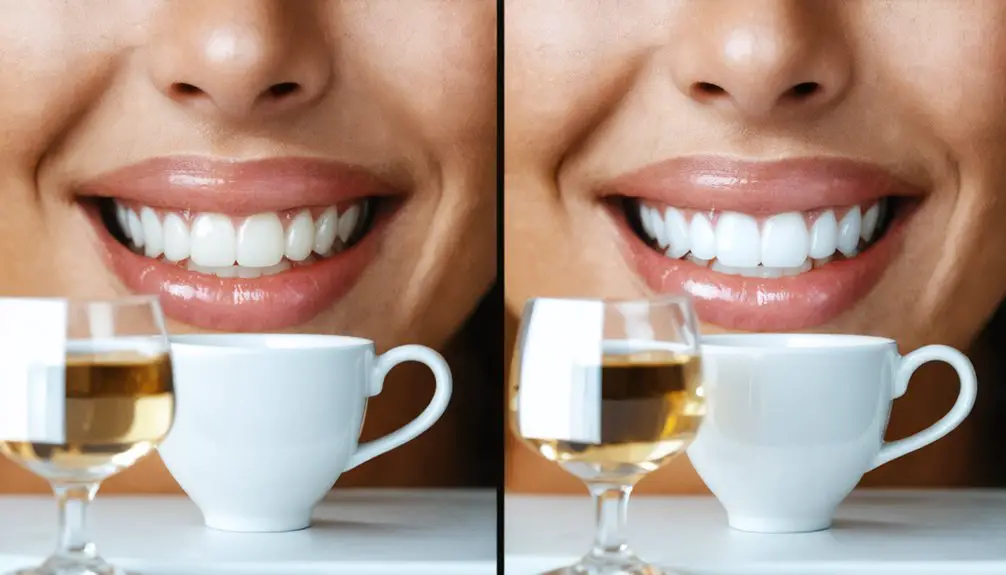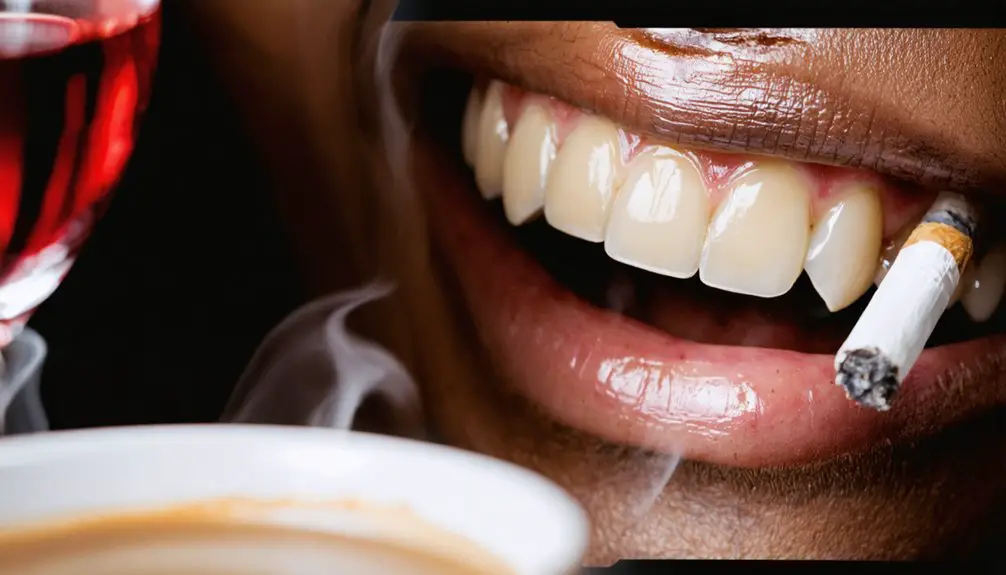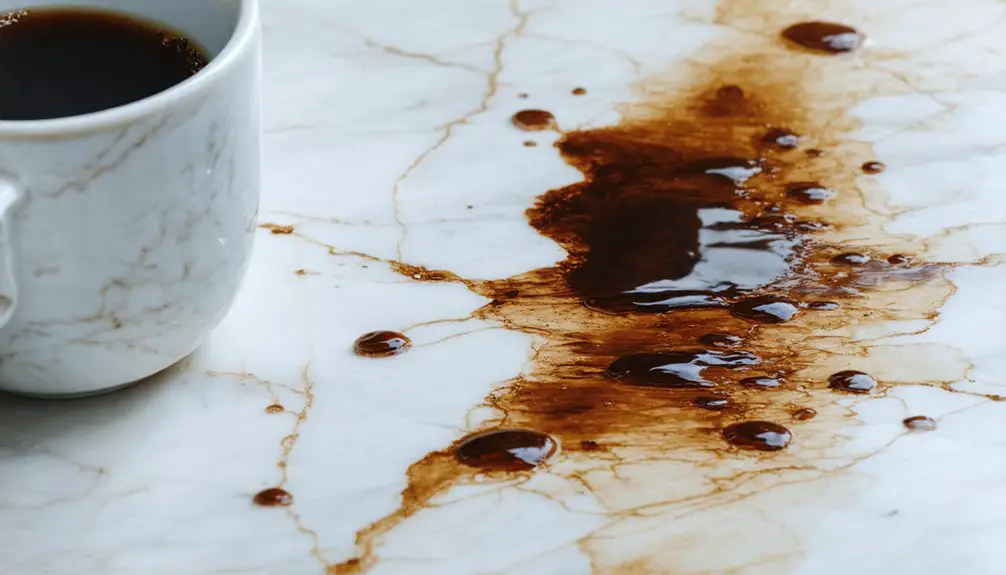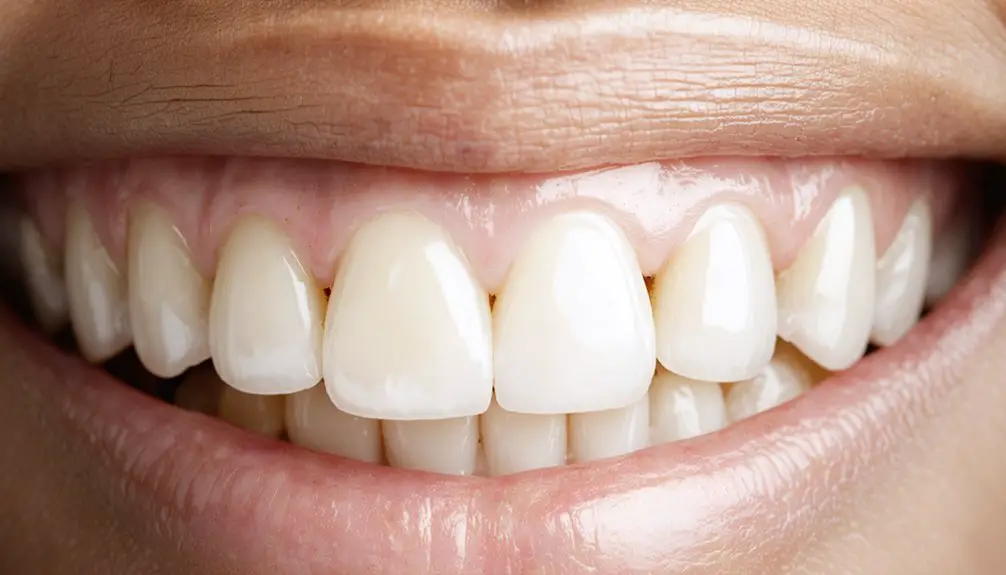Your teeth whitening results fade due to multiple factors working against your bright smile. Natural aging causes enamel erosion and darker dentin exposure, while daily exposure to staining foods, drinks, and lifestyle habits gradually discolor teeth. The whitening process itself creates microscopic changes in your enamel’s structure, making it more susceptible to new stains. Understanding these factors can help you maintain your whitening results more effectively.
Key Takeaways
- Daily exposure to staining foods and drinks containing tannins, like coffee and wine, gradually diminishes whitening results over time.
- Natural aging causes dentin to darken while enamel thins, making teeth appear more yellow despite previous whitening treatments.
- Bleaching agents alter enamel’s microscopic structure, making teeth temporarily more susceptible to new stains after treatment.
- Poor oral hygiene allows plaque buildup and surface stains to accumulate, accelerating the reversal of whitening effects.
- Acidic foods and drinks erode enamel, exposing more of the yellowish dentin underneath and compromising whitening results.
The Science Behind Tooth Dehydration and Rehydration
When your teeth become dehydrated, they undergo rapid and significant color changes that can mask their true shade. Within the first minute of tooth dehydration, 87% of teeth show noticeable whitening effects as water leaves the enamel and dentin structures.
This dehydration alters the optical properties of your teeth, increasing light scattering and reflection from dry enamel surfaces. After just one minute, 72% of teeth exceed the clinical threshold for acceptable color variation. Similar to how comprehensive databases help track research outcomes, monitoring tooth color changes requires systematic observation.
The rehydration process is surprisingly slow. Even after 15 minutes of rehydration, 90% of teeth haven’t returned to their baseline color.
This explains why teeth often appear whiter immediately after dental procedures but gradually return to their natural shade. Understanding this process is essential because temporary dehydration-induced whitening can lead to mismatched shade selection during dental work or unrealistic expectations during whitening treatments.
Understanding Natural Aging and Enamel Changes
Beyond temporary color changes from dehydration, your teeth undergo significant structural modifications as you age.
Your enamel’s surface transforms from a scalloped pattern in youth to a smoother texture in adulthood, while perikymata gradually disappear. As you encounter daily acids from food, drinks, and bacteria, enamel erosion accelerates, creating rougher surfaces and deeper grooves. Acidic environments from frequent consumption of coffee, tea, and carbonated beverages can speed up this deterioration process.
Simultaneously, dentin aging occurs beneath your enamel, becoming denser and darker over time. Since enamel is translucent, this underlying change makes your teeth appear more yellow or brown. The loss of enamel is permanent and cannot be reversed naturally.
Combined with mechanical wear from chewing and grinding, your enamel thins while exposing more of the darkened dentin. Gum recession further compounds these effects by revealing vulnerable root surfaces and potentially compromising your teeth’s structural integrity.
Impact of Daily Diet and Lifestyle Choices
Your daily consumption of staining foods and drinks like coffee, red wine, and dark berries can greatly diminish your teeth whitening results, especially when these items aren’t followed by proper rinsing or brushing. Incorporating crunchy fresh produce into your diet can naturally help remove surface stains and maintain whitening effects.
Acidic citrus fruits and sodas contribute to enamel erosion, making teeth appear more yellow over time as the underlying dentin becomes exposed.
Tobacco use introduces tar and nicotine compounds that rapidly reverse whitening effects, making smoking one of the most detrimental habits for maintaining bright teeth.
Maintaining proper hydration throughout the day helps protect your whitening results by promoting saliva production, which naturally cleanses your teeth and neutralizes harmful acids that can weaken enamel.
Staining Foods and Drinks
The daily consumption of certain foods and beverages can markedly impact the longevity of teeth whitening results. Your teeth are particularly vulnerable to staining beverages like coffee, tea, and red wine, which contain tannins and pigment compounds that readily bind to freshly whitened enamel. Professional dentists recommend regular cleanings to help combat persistent staining effects.
Dark-colored fruits, especially berries and their juices, pose similar risks due to their concentrated anthocyanins. Regular consumption of curry dishes containing turmeric and curcumin can cause significant yellowing of teeth.
You’ll need to be cautious with acidic and colored condiments, such as tomato and soy sauce, as they can weaken enamel and enhance discoloration.
Colored soft drinks and cola are equally problematic, combining artificial dyes with enamel-softening acids.
To maintain your whitening results, consider using a straw when drinking staining beverages, rinse your mouth afterward, and moderate your consumption of these items.
Tobacco’s Damaging Effects
While teeth whitening treatments can effectively brighten your smile, tobacco use severely compromises both immediate results and long-term outcomes. Smokers experience faster yellowing teeth almost immediately after whitening procedures. The nicotine and tar from tobacco deeply penetrate your tooth enamel, creating stubborn stains that resist standard whitening procedures. Tobacco stains not only discolor the surface but become embedded within the enamel structure, making them particularly challenging to remove. Regular dental cleanings and checkups are essential since surface stains accumulate rapidly for smokers.
- Tobacco chemicals weaken your enamel through erosion, making teeth more susceptible to future staining and less responsive to whitening agents.
- Your whitening results will fade markedly faster – typically lasting less than 6 months compared to up to 2 years for non-smokers.
- Professional treatments require stronger concentrations and more frequent applications to combat tobacco stains, yet results remain limited without smoking cessation.
Daily Hydration Habits
Maintaining proper hydration habits greatly impacts the success and longevity of teeth whitening results. The hydration importance extends beyond general health, as adequate fluid intake directly affects your oral environment.
When you’re properly hydrated, your body produces sufficient saliva, which naturally remineralizes enamel and washes away staining agents. Your saliva function plays a critical role in preserving whitening results.
If you experience dry mouth, whether from medications or insufficient water intake, you’ll face increased risks of stain buildup and faster discoloration. To protect your investment in teeth whitening, drink water after meals to dilute staining substances and remove debris.
This simple habit helps maintain enamel health and prevents the development of rough surfaces where stains can easily attach.
Professional Vs At-Home Whitening Duration

When you choose professional in-office teeth whitening, you can expect results to last between 12 to 24 months due to the stronger bleaching agents and LED light activation used during treatment.
At-home whitening with custom trays typically maintains results for 6 to 12 months, while over-the-counter products may only keep teeth whiter for 1 to 3 months.
Your lifestyle choices and oral hygiene habits will greatly impact the longevity of any whitening method you select, making proper maintenance essential for prolonged results.
Professional Whitening Lasts Longer
Although both professional and at-home teeth whitening treatments can effectively brighten your smile, professional treatments typically deliver longer-lasting results, with effects persisting anywhere from 6 months to 2 years.
Professional techniques achieve superior whitening longevity through higher concentrations of bleaching agents and controlled application methods, resulting in more dramatic shade improvements of up to 8 shades in a single session.
- Professional whitening can achieve up to 10-15 shades lighter immediately after treatment, compared to 1-2 shades with at-home options.
- Without exposure to staining substances like coffee or wine, professional results can last beyond one year.
- Combining in-office treatments with periodic at-home maintenance provides ideal long-term color stability and extends the duration of your results.
At-Home Results Vary Widely
The success of at-home teeth whitening treatments varies considerably between individuals, with typical results requiring 2-3 weeks of consistent use to achieve desired shade improvements.
You’ll likely notice subtle changes after your first application, with more visible results developing within the first week of treatment.
Individual variability plays a significant role in treatment outcomes. Your original tooth shade, sensitivity levels, and lifestyle habits directly impact the effectiveness of whitening treatments.
While at-home methods require longer treatment times than in-office procedures (7-140 hours versus 30-60 minutes), they often produce better overall results.
Treatment consistency is essential – you’ll need to follow recommended application times of 30-60 minutes per session, though this may extend to 2 hours for heavily stained teeth if sensitivity remains low.
Role of Proper Dental Care in Result Longevity
Maintaining proper dental care plays a decisive role in extending the lifespan of your teeth whitening results. Your daily oral hygiene routine, combined with professional maintenance products, creates a foundation for lasting brightness.
Regular brushing and flossing remove surface pigments while preventing plaque buildup that can diminish your whitening investment.
- Brush twice daily with whitening toothpaste and use maintenance products as recommended by your dentist to break down light surface stains
- Schedule professional cleanings every six months to remove stubborn tartar and preserve whiteness
- Rinse or brush promptly after consuming staining beverages to minimize pigment contact with your enamel
Your saliva also supports whitening longevity, so stay hydrated and consider using alcohol-free fluoride rinses to strengthen your enamel against future stains.
Common Staining Agents That Accelerate Fading

Understanding which substances accelerate whitening fade helps you protect your investment in a brighter smile.
The most aggressive staining agents include tannin-rich beverages like coffee, tea, and red wine, which quickly bind to your newly whitened enamel. Berries and dark-pigmented fruits can also compromise your results through their phenolic compounds.
Tobacco products pose a considerable threat, as their tar and nicotine compounds deeply penetrate enamel pores created during whitening.
Additional fading factors include acidic foods and beverages that erode enamel, making it more susceptible to stains. Certain medications, particularly antibiotics and antipsychotics, can cause both surface and internal discoloration.
Even environmental exposures and lifestyle habits, such as frequent consumption of dark-colored sodas or using pigmented mouthwash, can considerably shorten the lifespan of your whitening results.
Structural Changes and Their Effect on Color Stability
When teeth undergo professional whitening treatments, structural modifications occur within the enamel’s microscopic architecture that directly influence long-term color stability.
The oxidative stress from bleaching agents alters your enamel microstructure, making it more susceptible to future staining and color changes.
- Hydrogen peroxide’s acidic nature during treatment can etch your enamel surface, creating microscopic pathways that allow new stains to penetrate more easily.
- Changes in your enamel’s crystal structure affect how light interacts with your teeth, impacting both immediate whitening results and their longevity.
- The combination of enamel and dentin changes creates varying degrees of color stability, with some areas maintaining whiteness longer than others.
Regular maintenance treatments using lower concentration agents can help preserve both structural integrity and whitening results over time.
Frequently Asked Questions
Can Teeth Whitening Damage Existing Dental Work Like Crowns or Veneers?
While whitening won’t structurally damage your crowns or veneers, you’ll notice discoloration differences since these materials don’t whiten like natural teeth. You might experience temporary sensitivity around existing dental work.
Is It Safe to Whiten Teeth During Pregnancy or While Breastfeeding?
Due to limited research on teeth whitening safety and pregnancy effects, you shouldn’t whiten your teeth while pregnant or breastfeeding. Wait until after these periods to avoid potential risks to your baby.
How Long Should I Wait Between Professional Whitening Treatments?
You should wait 6-12 months between professional teeth whitening treatments for ideal treatment intervals. Your dentist can determine the best frequency based on your specific needs and sensitivity levels.
Does Taking Calcium Supplements Help Maintain Whitening Results Longer?
Like armor for your smile, calcium supplements can help extend whitening duration through improved enamel strength. For ideal calcium absorption, pair them with vitamin D and take during meals.
Can Certain Medications Affect How Long Teeth Whitening Results Last?
Yes, certain medications can greatly affect whitening duration through intrinsic staining, extrinsic discoloration, or by altering your oral environment. Common culprits include tetracycline antibiotics, antihistamines, and antihypertensive drugs.
References
- https://cosmeticdental.com/white-smile-fading-couple-days-zoom-whitening/
- https://www.parkcentraldentaltx.com/blog/why-your-whitening-results-dont-last–and-how-to-make-them-stick
- https://www.easydentalimplantcenter.com/blog/teeth-whitening-maintenance
- https://www.wdsnaperville.com/how-long-does-teeth-whitening-last–tips-to-maintain-your-bright-smile
- https://pmc.ncbi.nlm.nih.gov/articles/PMC4058574/
- https://cdr.lib.unc.edu/downloads/jq085q166
- https://onlinelibrary.wiley.com/doi/abs/10.1111/jerd.12461
- https://pubmed.ncbi.nlm.nih.gov/30801926/
- https://pmc.ncbi.nlm.nih.gov/articles/PMC10692694/
- https://iro.uiowa.edu/esploro/outputs/graduate/Effect-Of-dehydration-on-in-office-bleaching/9983777037802771



